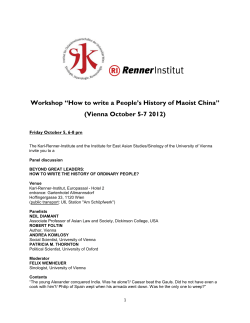
Vienna`s role in the life of Mihály Munkácsy
University of Szeged Faculty of Arts Vienna’s role in the life of Mihály Munkácsy Doctoral dissertation Polenyák Ivett PhD supervisor: Dr. Deák Ágnes Szeged, 2014 1 The aim of this dissertation is to contribute to the professional literature regarding the work and life of the Hungarian painter, Mihály Munkácsy, who was well known in the whole world in the 19th century. Our contribution completes the existing literature - the analysis of which is based on the tools of the history of arts - with more fact based research and using original sources from the archives, and thus we seek to bridge the gap between historians and historians of arts. At the centre of our research stands the investigation of the period that Mihály Munkácsy spent in Vienna. This period turned out to be very important for the rest of his life, also reflected in his paintings. Another objective of our work is to clarify the thus far not cleared or misinterpreted questions concerning Munkácsy’s artistic work and life. The first chapter of the dissertation studies the familial background of Munkácsy. The questions we ask here and that we seek to answer are: 1.) the origins of the family of Munkácsy, 2.) the sources of his patriotic feelings that accompany him during his whole life, and 3.) the extent to which he spoke German before he started his studies at the academy in Vienna. The second chapter deals with the development of the Hungarian art life and the emergence of the Hungarian art society from the viewpoints of the personal artistic development of Mihály Munkácsy. Our work clarifies two things. First, the origins of the Hungarian art society can be traced back to the English, German and Austrian art societies and not to the French one, as voiced in the Hungarian literature. Second, we emphasise the role of the emerging wealthy bourgeoisie in promoting arts – a fact that was downplayed in the earlier literature. As a matter of fact, the mécénat was viewed by many wealthy bourgeois as a way to integrate in the upper classes of the society that also acted as a financier of the arts. The third chapter focuses on the artistic development of Munkácsy in his early years and during his stay in Vienna. Using primary sources, we document the outstanding influence of Karl Rahl on the young Munkácsy that already started before Munkácsy arrived to Vienna, given that his promoters in Hungary, namely Elek Szamossy and Mór Than, were former students of Karl Rahl. Our work analyses Munkácsy’s stay in Vienna that is largely neglected or even ignored in the literature. This is the first attempt to document the year 1865 in Munkácsy’s life on the basis of personal letters of the painter. We also shed light on a number of thus far badly understood issues. First, contrary to Lajos Végvári’s claims according to which Munkácsy did not like Vienna, the personal correspondence of Munkácsy witnesses the joy with which Munkácsy spent his time in Vienna, despite the financial problems he had at the beginning of his stay. Second, we show that the encounter with Karl Rahl influenced Munkácsy’s style to a great extent for instance via the technique called “Grau in Grau” (grey in grey). Third, we uncover that Munkácsy was not an ‘official’ student of Karl Rahl, but instead, he visited Rahl’s art saloon where he took private lessons. Furthermore, Munkácsy was registered at the introductory course at the academy in Vienna where he studied under Karl Wurzinger, and was not a student of Professors Führich and Zimmerman, as mistakenly claimed in the literature. Finally, our research shows that Munkácsy did not leave Vienna because he had difficulties to pay the tuition fee – a claim formulated in the literature - but because he wanted to go to Berlin to take lessons from Ludwig Knaus, his idol; because he found the academy not interesting enough and because his master, Karl Rahl, died in 1865. The last two chapters of this dissertation look at the influence of Ludwig Knaus and the return to Vienna. Ludwig Knaus also had a large impact on Munkácsy and it was via his intermediation that Munkácsy came in contact with the works of Gusav Courbet. The last chapter documents Munkácsy’s participation at the world exposition that took place in Vienna in 1873. Vienna became important for Munkácsy not only via his participation at the world exposition where he declared himself officially as a Hungarian artist, notwithstanding the fact that he was living abroad for many years, but also because he received a number of high rewards – including the title of nobility- from the Austro-Hungarian emperor. He was in charge of carrying out the task of painting the ceiling fresco of the Museum of the History of Arts in Vienna, an ultimo privilege of the Emperor. Nevertheless, while the literature views Munkácsy’s ceiling paintings as expressing artistic virtuosity, original documents studied in this dissertation show that Munkácsy had to use the outlines of the painter Hans Makart. To summarise, the research carried out in this dissertation made it clear that the issues that were considered in the literature as closed or undebatable concerning Munkácsy’s life were in fact studied not deep enough. Overall, our research showed that the impulses Munkácsy had in his young years – including his stay in Vienna – had a much larger effect on his style and development than usually thought in the literature. On the one hand, this dissertation shed new light on some of the hypothesis formulated in the literature by either dismissing them or validating them with hard evidence. On the other hand, this work showed the necessity of further research. Against this background, we hope this dissertation is the first step towards a comprehensive Munkácsy monography that will be also concerned with Munkácsy’s life in Paris and his relationship to Hans Makart. 3 Bibliography Polenyák, Ivett (2010), Die Rolle des Mäzenatentums in Österreich – Ungarn im Spiegel der Kunstvereine, in: Hlavacka, M., Pokorná, M., T.W. Pavlícek (eds): Collective and Individual Patronage and the Culture of Public Donation in Civil Society in the 19th and 20th Centuries in Central Europe. The Institute of History Prague, Prága, 2010, p. 466-478. Polenyák, Ivett (2011), Munkácsy Mihály, avagy művészi hírnév és nemesség, in Antos B., Tamás Á. (eds): Szemelvények ötszáz év magyar történelméből, Szegedi Tudományegyetem, Szeged, 2011, p. 51-59. Polenyák, Ivett (2012), Munkácsy Mihály és a korabeli magyar festőelit az 1873- as bécsi világkiállításon, AETAS, 27(1), p. 159-176. Polenyák, Ivett (2012), The Influence of the Venetian Scool on the development of Hungarian painting arts, as intermediated, in: Conference proceedings, International Institute of Social and Economic Sciences, Palermo, Sicily, 2012, április 15-18. ISBN: 978-80-905241-0-1, p. 254-259. Polenyák, Ivett (2012), The Vienna Universal Exibition 1873: the art of Mihály Munkácsy in light of the German Criticism, in: In: Brisova, K., Knejp J. (eds) Changes of Central Europe Since the middle of 18th century to present, conference proceedings, International conference of doctoral candidates, Ostrava, p. 37-45. Polenyák, Ivett (2012), Munkácsy Mihály és Karl Rahl kapcsolata (1865) - Történészi rekonstrukció a bécsi anyagok tükrében, in: Történelmi emlékezet és identitás. Tanulmányok, Heraldika Kiadó, 2012, p. 128-144. 5
© Copyright 2025









